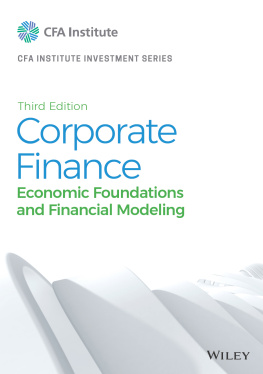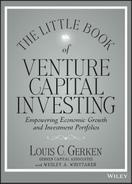Advanced Capital Budgeting
This book is a companion volume to the author's classic The Capital Budgeting Decision and explores the complexities of capital budgeting as well as the opportunities to improve the decision process where risk and time are important elements.
There is a long list of contenders for the next breakthrough for making capital budgeting decisions and this book gives in-depth coverage to:
Real options. The value of a project must take into consideration the flexibility that it provides management, acknowledging the option of making decisions in the future when more information is available. This book emphasizes the need to assign a value to this flexibility, and how option-pricing theory (also known as contingent claims analysis) sometimes provides a method for valuing flexibility.
Decomposing cash flows. A project consists of many series of cash flows and each series deserves its own specific risk-adjusted discount rate. Decomposing the cash flows of an investment highlights the fact that while managers are generally aware that divisions and projects have different risks, too often they neglect the fact that the cash flow components may also have different risks, with severe consequences on the quality of the decision-making.
Designed to assist business decisions at all levels, the emphasis is on the applications of capital budgeting techniques to a variety of issues. These include the hugely significant buy versus lease decision which costs corporations billions each year. Current business decisions also need to be made considering the cross-border implications, and global business aspects, identifying the specific aspects of international investment decisions, which appear throughout the book.
Harold Bierman, Jr. is the Nicholas H. Noyes Professor of Business Administration at the Johnson Graduate School of Management, Cornell University.
Seymour Smidt is Professor Emeritus at the Johnson Graduate School of Management, Cornell University.
Advanced Capital Budgeting
Refinements in the economic analysis of investment projects
Harold Bierman, Jr. and Seymour Smidt

First published 2007 by Routledge
270 Madison Ave, New York, NY 10016
Simultaneously published in Great Britain
by Routledge
2 Park Square, Milton Park, Abingdon, Oxon OX14 4RN
Routledge is an imprint of the Taylor & Francis Group, an informa business
2007 Harold Bierman, Jr. and Seymour Smidt
Typeset in Perpetua and Bell Gothic by Newgen Imaging Systems (P) Ltd, Chennai, India
Printed and bound in Great Britain by TJ International Ltd, Padstow, Cornwall
All rights reserved. No part of this book may be reprinted or reproduced or utilized in any form or by any electronic, mechanical, or other means, now known or hereafter invented, including photocopying and recording, or in any information storage or retrieval system, without permission in writing from the publishers.
Library of Congress Cataloging in Publication Data
Bierman, Harold.
Advanced capital budgeting: refinements in the economic analysis of investment projects / Harold Bierman, Jr. and Seymour Smidt.
p. cm.
Includes bibliographical references and index.
1. Capital budget. 2. Capital investments Evaluation. I. Smidt, Seymour. II. Title.
HG4028.C4B537 2006
British Library Cataloguing in Publication Data
A catalogue record for this book is available from the British Library
| ISBN10: 0-415-77205-2 (hbk) | ISBN13: 978-0-415-77205-1 (hbk) |
| ISBN10: 0-415-77206-0 (pbk) | ISBN13: 978-0-415-77206-8 (pbk) |
Contents
PART I
CAPITAL BUDGETING AND VALUATION UNDER CERTAINTY |
PART II
CAPITAL BUDGETING AND VALUATION UNDER UNCERTAINTY |
PART III
OPTION THEORY AS A CAPITAL BUDGETING TOOL |
PART IV
APPLICATIONS OF CAPITAL BUDGETING |
FIGURES
TABLES
The history of capital budgeting is a series of time periods where managers thought they had found exact solutions to making investment decisions only to find that new improved methods of thinking of the issues introduced complexities and solutions. Thus until early in the 1950s the payback and accounting return on investment were the primary methods used by business. The internal rate of return (called by different names) then reigned for a brief time in the mid fifties only to be replaced by the net present value method. Both of these discounted cash flow methods initially used the firm's weighted average cost of capital either as the rate of discount for computing present values or as the required return. It was then recognized that not only did a corporation have a risk measure, but so did divisions, and individual projects. We argue in this book that investments have cash flow components that might require different discount rates.
Now there is a long list of contenders for the next break-through for making capital budgeting decisions. Leading the list are real options. The value of a project must take into consideration the flexibility that it provides management. One project may commit management to a definite course of action; another may provide flexibility by giving managers the alternative of making decisions in the future when more information is available. We emphasize the need to assign a value to this flexibility. We point out that option-pricing theory (also known as contingent claims analysis) sometimes provides a method for valuing flexibility. But even though many knowledgeable managers already incorporate the basic concepts, it is useful to acknowledge formally the necessity of considering all decision alternatives and of using option theory where appropriate and feasible.
Close behind options in importance is the thought that a project consists of many series of cash flows and that each series deserves its own specific risk adjusted discount rate. Decomposing the cash flows of an investment may lead to significantly different results than the calculation of the net present value of an investment's net cash flow. We expand on this conjecture in this book.
Even the use of one risk adjusted rate for a series of cash flows must be questioned. Under what conditions is it correct to use (1 + r)-n with the same r for all values of n to compute the present value of a cash flow?
This book explores the complexities of capital budgeting as well as the opportunities to improve the decision process where risk and time are important elements.
We assume that the reader of this book has read and understood the core chapters of The Capital Budgeting Decision or the equivalent material in a basic corporate finance text. In this book, we have not gone over the basic concepts of time value, NPV, or IRR. If you are not familiar with these concepts, we strongly recommend that you do some reading to establish a necessary foundation before starting this book.
This book assumes the reader has an appreciation for the usefulness of net present value (NPV) and the cases where NPV is superior to alternative measures of investment worth. Part I of this book summarizes the basic elements of time discounting but the two chapters do not attempt to replicate the essentials of capital budgeting.
contains complex examples that can be omitted on first reading.
Next page








